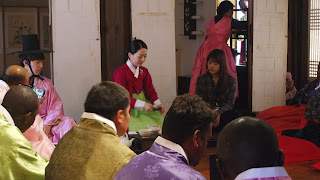In 1998, this village was opened after five authentic Hanok(traditional Korean housed) that were scattered in the city moved to the northeast of this site and original terrain shape and pavilions and ponds were restored. Native trees and grasses were planted, and the valley was built to enable natural flow of water.
The buildings are opened with free entrance fee as follows:
- 09:00 ~ 21:00 (Apr to Oct)
- 09:00 ~ 20:00 (Nov to Mar)
- Closed on every Tuesday
We can reach to this village by subway Line 3 or Line 4. It takes around five minutes on foot from subway exit 3 (directly from Line 3) or 4.
* From Eungam Station of Line 6 to Chungmuro Station (Line 3)
- Platform no 7-2 (see the floor of the paltform) in Eungam Station to Bulgwang Station by Line 6
- Transfer Line 3 at platform no 5-2 in Bulgwang Station to the direction of Chungmuro after going up
by two escalators
- Exit through No. 2 in Chungmuro Station, go forward and them turn left.
- It takes around 40 minutes.
1. Cheonugak Pavilion and Cheonghakji Pond
The Cheonugak Pavilion and Cheonghakji is in left side of the entrance gate. Just before the pavilion, there is a small straw building with Korean A-fram carriers.
In a stage in front of the pavilion, Taekwondo (Korean martial art) demonstration is performed at 3:00 pm every day except for Tue from May to Nov. This Taekwondo demonstration expresses its power, as well as its inner restraint, based on the long history and tradition of the martial art. The spirits of ancient Koreans inherent in Taekwondo are expressed through this performance true to its tradition.
Sepcially Korean traditional Bongsan masked dance in the saqure would be ferformed.
In the side of the square, there is a straw building showing rice straw household items and providing visitors with an exercing opportunity.
2. Five Hanok Buildings
The five hanok buildings with different styles were relocated and restored, from that of a nobleman's house to that of a commoner's. The furniture inside the houses was also reproduced true to life, so that visitors can havew a vivid glimpse of life in the past.A. Carpenter Yi Seung-eop's House
The house w3as built by master carpenter Yi Seung-eop, who participated in the rebuilding of Gyeongbokgung Palace from 1865 to 1868. A special roofing technique was used for the inner quarters, kitchen, and the main room. The banisters and wooden porch are perfect examples of the simple and practical beauty of classical architecture.
B. Yun Family's House
This house was built in the 1910's, and belonged to Yun Deok-yeong. The house is a replica, because the original was too old and vulnerable to damage to be relocated. It shows it belonged to the highest class.
C. Yun Tack-yeong's Jaesil
This house was established by Yun Tack-yeong when his daughter, Empress Sunjeonghyo, became the wife of Emperor Sunjong, 1910. His main purpose was to make a comfortable place for the emperor when he visited the house for ancestral rites. The house has a very rare form , where the family shrine is situated overground.
From Apr to Dec, Korean traditional medical experience program is carried out in this house.
D. Min Family's House
This building is part of the mansion of Min Yeong-hui, and is thought to have been built in the 1870s. It relocated and remodeled the remaining inner quarters, and rebuilt the opposite room, guest house, and separate house. The The house shows it belonged to the highest class through some features, including the rare type of parallelarrangement of the main room and the kitchen, and its spacious wooden structure.
In this house, there is a traditional etiquette class (Advance booking is required and it is available only for a group (fee of KRW15,000). The participants cna learn Korea's general decorum, tea ceremony, and experience traditional plays.
In addition, traditional wedding ceremony would be performed on Sat and Sun throughtMar and Nov (11:00, 13:00, 15:00). The ceremony is held in front yard of a hanok according to the official decorum of the noble class in this house (advance booking is required).
E. General Kim Choon-yeong's House
Built in the 1890s, this house belonged to Kim Choon-yeong, who served as the General of the Five Commands during the late Joseon Dynasty period. While its general style is modest and unsophisticated, some features, such as the firewall facing the street, give the house a refined air. We can see how hanoks adapted to urban, populated surroundings through the main gate, which is curved instead of being stright, and the efficient way of arranging each unit of the building.
3. Play Ground for Traditional Games and Pigemjeong Pavilion
There is a play ground for traditional games at a squre by Pigemjeng Pavilion.
4. Seoul Millennium Time Capsule
in 1994, to mark Seoul's 600th anniversary as the capital of Korea, 600 items thought to be best represent the city were buried to be opened on Nov 29, 2394, which will mark the city's 1,000th anniversary. The square is built in the shape of a meterorite crater, symbolizing perpetuality, while the Time Capsule is made in the shape of the Boshingak Bell.
5. Traditional GardenOur ancestors used to enjoy their leisure time in pavilions nestled in the scenic mountain of namsan. The rapid development of the cities, however, significantly damaged the mountain and environment. We have healed the acarred mountain, built gazebos and ponds, and are growing native species of trees.
6. Kugakdang (Traditional Theater)
Gugakdang is the first theater in the nation specialized in gugak (traditional Korean music) with the goal of promoting traditional arts performances and sharing the beauty of gugak with more people. The building, which adopts the classical Korean architectual style, not only shows the identity and history of Korea but is also optimized to deliver the natural sounds of gugak undistorted.










































































댓글 없음:
댓글 쓰기